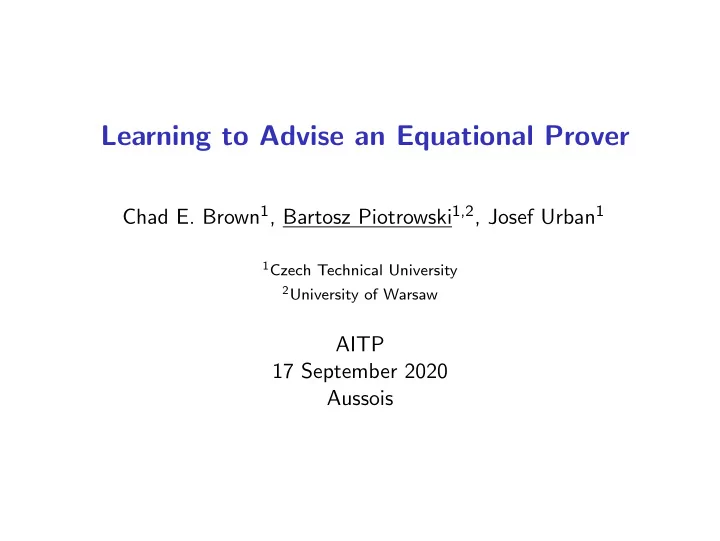

Learning to Advise an Equational Prover Chad E. Brown 1 , Bartosz Piotrowski 1,2 , Josef Urban 1 1 Czech Technical University 2 University of Warsaw AITP 17 September 2020 Aussois
Introduction • aimleap is a simple prover for solving equations like this one: T(T(L(x,y,z),w),L(x,y,z)\x) = T((L(x,y,z)\x)\x,w) . • aimleap can benefit from an advisor which can estimate lengths of proofs of equations s = t . • In this work we provide a machine-learned advisor to aimleap . • We use data coming from the AIM project.
Search procedure in aimleap prover Initial parameters: • s = t – an equation to be proven, • A – a set of known equations; we fixed a set of 87 equations, • n – a maximum allowed distance; we set it to 10, Procedure: 1. If s and t are unifiable, then report success. 2. If n = 0, then report failure. 3. Compute a finite set of paramodulants s i = t i . These are defined as rewrites of s = t by a single equation from A . 4. Order these paramodulants using an advisor, filtering out those which the advisor deems to require more than n − 1 paramodulation steps to complete the proof, and for each one ask if s i = t i is provable in n − 1 steps. Another constraint: • m – abstract time limit (# of recursive calls); we set it to 100.
Search procedure in aimleap prover
87 basic equations (Loop Axioms) (70 additional equations) lid : e * x = x x / x = e rid : x * e = x e \ x = x b1 : x \ (x * y) = y x / e = x b2 : x * (x \ y) = y x \ x = e s1 : (x * y) / y = x (y / x) \ y = x s2 : (x / y) * y = x x * T(y,x) = y * x T(x / y,y) = y \ x (Definitions) (x * T(y,x)) / x = y a(x,y,z) := (x*(y*z))\((x*y)*z) (x * y) * K(y,x) = y * x K(x,y) := (y*x)\(x*y) T(x,x \ y) = (x \ y) \ y T(u,x) := x\(u*x) x*T(T(y,x),z) = T(y,z)*x L(u,x,y) := (y*x)\(y*(x*u)) T(T(x/y,z),y) = T(y\x,z) R(u,x,y) := ((u*x)*y)/(x*y) (x*y)*L(z,y,x) = x*(y*z) L(x\y,x,z) = (z*x)\(z*y) (AIM Axioms) R(x,y,z)*(y*z) = (x*y)*z TT: T(T(u,x),y) = T(T(u,y),x) R(x/y,y,z) = (x*z)/(y*z) TL: T(L(u,x,y),z) = L(T(u,z),x,y) x*((x\e)*y) = L(y,x\e,x) TR: T(R(u,x,y),z) = R(T(u,z),x,y) (x\e)*y = x\L(y,x\e,x) LR: L(R(u,x,y),z,w) = R(L(u,z,w),x,y) . LL: L(L(u,x,y),z,w) = L(L(u,z,w),x,y) . RR: R(R(u,x,y),z,w) = R(R(u,z,w),x,y) .
Data set • Veroff obtained a large number of AIM proofs using Prover9. • We extracted 3468 equations from them. • Each equation s = t has recorded distance between s and t . Distance Number of problems 2 1641 (47.3%) 3 869 (25.0%) 4 353 (10.2%) 5 284 (8.2%) 6–10 372 (10.5%) • Additionally, we created 10000 synthetic equations. • The extracted examples are used for testing, the synthetic ones – for training.
Data set – examples Bunch of training examples of form ( s = t , dist ): s t dist T(T(T(T(x,y),z),x),w T(T(T(T(x,y),x),z),w 1 T((e/x)*y,z T(((e/x)*x)\((e/x)*y),z 2 T(e\((e/x)*y),z L(T(x\y,z),x,e/x 3 x*L(x\(x/y),z,w ((x/y)*y)*L(L(y\e,z,w),y,x/y 4 (X*Y)/L(x\Y,x,(y*z)/(w*z)) R(y/w,w,z)*x 5 K((x\y)\y,z)*T(x,x\y X/((K((x\y)\y,z)*((x\y)\y))\X 6 (x/((y\e)*x))*T(z,R(y,y\e,x) z*R(X/(y\X),y\e,x 9
Rote learner • As a sanity check an oracle advisor aka rote learner was used: • for all (sub)goals seen in the proofs it returns the true distance, • for unseen goals it returns 50 (effectively prunning them out). • The aimleap prover with the oracle advisor can reprove all the 3465 problems (with no backtracking). • We tested the rote learner in a cross-validation scenario: • data split into 10 parts, • the rote learner tested on one part can use knowledge only from the remaining 9 parts. • Success rate in that setting: 21.9% (800 problems solved).
Constant distance • We tested an advisor giving simply constant distance c for each equation s = t for which s is not equal t , or 0 otherwise. • The results: Constant Solved problems 0 0 1 – 7 135 (3.9%) 8 138 (4.0%) 9 1739 (50.1%) 10 132 (3.8%) • Constant distance 9 performs so well because it makes the search more breadth-first-like and the prover easily solves all the goals with distances 1 and 2 ( ≈ 50% of the problems).
Training the advisor • For providing machine-learned advice we used XGBoost. • Training examples were fed into the model as features of pairs of terms and the corresponding distance between them. • We used ENIGMA-style features, i.e., paths of lengths 1–3 from the term’s parse tree, with numbers of their occurrences. • Hyperparameters of XGBoost were: objective function – mean squared error , number of boosting rounds – 1000, maximal depth of a decision tree – 10, learning rate – 0.1. • The advisor was trained on a separate set of 10000 synthetized examples.
Accuracy and search results of the advisor • On a cross-validation split the performance metrics of the trained advisor were: • root mean square error: 1.1, • accuracy: 59%. • aimleap with the advisor plugged-in and an additional constraint of 60 second time limit could solve 299 problems out of 3468 testing problems (only 9% ...) • But: there were 135 problems not solved by the rote learner and 18 problems not solved with any constant-distance advice.
First-order automated provers • For further comparison we gave the problems to three automated provers: Prover9, Waldmeister and E. • For all of them a timeout of 60 seconds was used. Not solved Prover Solved problems but solved by aimleap E 1342 (38.6%) or 2684 (77.4%) 113 Prover9 2037 (58.7%) 49 Waldmeister 2170 (62.6%) 92
Next experiment: synthetizing term in the middle • Try to guess term-in-the-middle : • Having produced the term, try to prove: LHS = term-in-the-middle and term-in-the-middle = RHS .
Recommend
More recommend